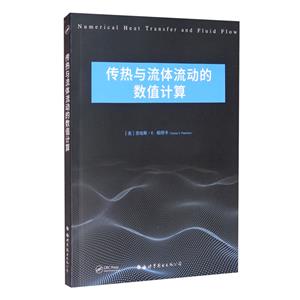-
>
宇宙、量子和人类心灵
-
>
(精)BBC地球故事系列-星际旅行
-
>
从一到无穷大
-
>
图说相对论(32开平装)
-
>
一本有趣又有料的化学书
-
>
刘薰宇的数学三书:原来数学可以这样学全3册
-
>
光学零件制造工艺学
Numerical heat transfer and fluid flow 版权信息
- ISBN:9787519283261
- 条形码:9787519283261 ; 978-7-5192-8326-1
- 装帧:一般胶版纸
- 册数:暂无
- 重量:暂无
- 所属分类:>>
Numerical heat transfer and fluid flow 内容简介
To illustrate the application of the material,problems are given at the end of some chapters. Most of the problems can be solved by using a pocket calculator,although some of them should be programmed for a digital computer.The problems are not meant for testing the student reader,but are included primarily for extending and enriching the learning process. They suggest alternative techniques and present additional material. At times,in my attempt to give a hint for the problem solution,I almost disclose the full answer. In such cases,arriving at the correct answer is not the main objective;the reader should focus on the message that the problem is designed to convey. This book carries the description of the numerical method to a point where the reader could begin to write a computer program. Indeed,the reader should be able to construct computer programs that generate the kind of results presented in the final chapter of the book. A range of computer programs of varying generality can be designed depending upon the nature of the problems to be solved. Many readers might have found it helpful if a representative computer program were included in tlus book. I did consider the possibility. However,the task of providing a reasonably general computer program,its detailed description,and several examples of its use seemed so formidable that it would have considerably delayed the publication of this book. For the time being,I have included a section on the preparation and testing of a computer program(Section 7.4),where many useful procedures and practices gathered through experience are described.
Numerical heat transfer and fluid flow 目录
1 INTRODUCTION
1.1 Scope of the Book
1.2 Methods of Prediction
1.2-1 Experimental Investigation
1.2-2 Theoretical Calculation
1.2-3 Advantages of a Theoretical Calculation
1.2-4 Disadvantages of a Theoretical Calculation
1.2-5 Choice of Prediction Method
1.3 Outline of the Book
2 MATHEMATICAL DESCRIPTION OF PHYSICAL PHENOMENA
2.1 Governing Differential Equations
2.1-1 Meaning of a Differential Equation
2.1-2 Conservation of a Chemical Species
2.1-3 The Energy Equation
2.1-4 A Momentum Equation
2.1 5 The Time-Averaged Equations for Turbulent Flow
2.1-6 The Turbulence-Kinetic-Energy Equation
2.1-7 The General Differential Equation
2.2 Nature of Coordinates
2.2-1 Independent Variables
2.2-2 Proper Choice of Coordinates
2.2-3 One-Way and Two-Way Coordinates
Problems
3 DISCRETIZATION METHODS
3.1 The Nature of Numerical Methods
3,1-1 The Task
3,1 2 The Discretization Concept
3.1-3 The Structure of the Discretization Equation
3.2 Methods of Deriving the Discretization Equations
3.2-1 Taylor-Series Formulation
3.2-2 Variational Formulation
3.2-3 Method of Weighted Residuals
3.2-4 Control-Volume Formulation
3.3 An Illustrative Example
3.4 The Four Basic Rules
3.5 Closure
Problems
4 HEAT CONDUCTION
4.1 Objectives of the Chapter
4.2 Steady One-dimensional Conduction
4.2-1 The Basic Equations
4.2-2 The Grid Spacing
4.2-3 The Interface Conductmty
4.2-4 Nonlinearity
4.2-5 Source-Term Linearization
4.2-6 Boundary Conditions
4.2-7 Solution of the Linear Algebraic Equations
4.3 Unsteady One-dimensional Conduction
4.3-1 The General Discretization Equation
4.3-2 Explicit, Crank-Nicolson, and Fully Implicit Schemes
4.3-3 The Fully Implicit Discretization Equation
4.4 Two- and Three-dimensional Situations
4.4-1 Discretization Equation for Two Dimensions
4.4-2 Discretization Equation for Three Dimensions
4.4-3 Solution of the Algebraic Equations
4.5 Overrelaxation and Underrelaxation
4.6 Some Geometric Considerations
4.6-1 Location of the Control-Volume Faces
4.6-2 Other Coordinate Systems
4.7 Closure
Problems
5 CONVECTION AND DIFFUSION
5.1 The Task
5.2 Steady One-dimensional Convection and Diffusion
5.2-1 A Preliminary Derivation
5.2-2 The Upwind Scheme
5.2-3 The Exact Solution
5.2-4 The Exponential Scheme
……
6 CALCULATION OF THE FLOW FIELD
7 FINISHING TOUCHES
8 SPECIAL TOPICS
9 ILLUSTRATIVE APPLICATIONS
Nomenclature
References
Index
Numerical heat transfer and fluid flow 作者简介
苏哈斯·V. 帕坦卡(Suhas V. Patankar,1941年2月22日-)是拥有印度、美国双重国籍的机械工程学家,明尼苏达大学荣誉退休教授,专长于计算流体力学。
- >
经典常谈
经典常谈
¥22.7¥39.8 - >
回忆爱玛侬
回忆爱玛侬
¥12.5¥32.8 - >
苦雨斋序跋文-周作人自编集
苦雨斋序跋文-周作人自编集
¥6.9¥16.0 - >
唐代进士录
唐代进士录
¥19.1¥39.8 - >
巴金-再思录
巴金-再思录
¥33.1¥46.0 - >
推拿
推拿
¥12.2¥32.0 - >
新文学天穹两巨星--鲁迅与胡适/红烛学术丛书(红烛学术丛书)
新文学天穹两巨星--鲁迅与胡适/红烛学术丛书(红烛学术丛书)
¥11.0¥23.0 - >
莉莉和章鱼
莉莉和章鱼
¥18.1¥42.0
-
相对论
¥10.2¥32 -
数学物理方法
¥13.2¥27 -
2022图书×抽奖盲袋
¥9.9¥25 -
2023读书月阅读盲盒——天黑,闭眼,刀谁?
¥42.3¥158 -
2022读者节纪念徽章-三星会员专属
¥45¥45.6
















